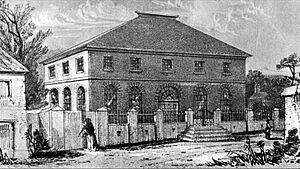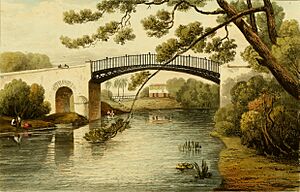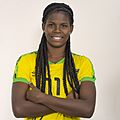Spanish Town facts for kids
Quick facts for kids
Spanish Town
|
|
|---|---|
|
Town
|
|

St. Jago de la Vega Cathedral
|
|
| Nickname(s):
Spain
|
|
| Country | |
| County | Middlesex |
| Parish | Saint Catherine |
| Founded as Villa de la Vega | 1534 |
| Population | |
| • Estimate
(2021)
|
145,018 |
| Time zone | UTC-5 (EST) |
| Area code(s) | 876 |
| Website | Official Website (2016): https://web.archive.org/web/20160513124054/http://www.spanishtownjamaica.com/ |
Spanish Town is a large town in Jamaica. It is the capital of the parish of St. Catherine. This town was once the capital of Jamaica. It served as the main city for both Spanish and British rulers from 1534 until 1872.
Spanish Town has many old buildings and important places. It is home to Jamaica's national archives. It also has one of the oldest Anglican churches outside of England.
Contents
History of Spanish Town
The Spanish founded a settlement here in 1534. They called it Villa de la Vega. Later, it was also known as Santiago de la Vega or St. Jago de la Vega. Before the Spanish arrived, Taino people had lived in this area for about a thousand years. This was the first European town built on the south side of the island.
In 1655, the English took over Jamaica. They renamed the settlement Spanish Town. This name honored its Spanish beginnings. The town was badly damaged during the English takeover. Because of this, Port Royal became the main city for a while. It acted as the unofficial capital when the English first ruled.
In 1692, a big earthquake destroyed Port Royal. By then, Spanish Town had been rebuilt. It became the capital again. Spanish Town remained the capital until 1872. At that time, the government moved to Kingston.
Kingston had grown a lot after the 1692 earthquake. By 1755, many people thought Spanish Town was no longer the best capital. In 1836, Governor Lionel Smith said the capital was "in ruins." He noted that businesses were not doing well there. In 1872, Governor John Peter Grant officially moved the capital to Kingston. Kingston was a larger port and was seen as a better main city for the island. After the government left, Spanish Town lost much of its importance and energy.
Exploring Spanish Town's Landmarks
Spanish Town is located on the west bank of the Rio Cobre river. It is about 13 miles from Kingston. The town's history was shaped by two main periods. These were Spanish rule (1534-1655) and English rule (1655-1872). The Anglican Church now uses a cathedral that was built in the 16th century.
The old buildings and street names show the town's history. For example, Red Church and White Church streets refer to old Spanish chapels. Monk Street is named after a monastery that used to be there. Nugent and Manchester streets are named after British governors. King Street passes the King's House, which was the governor's home until 1872. Constitution Street is near the Square, which was the island's old government center.
The Old Iron Bridge
Spanish Town has a very old cast-iron bridge. It was designed by Thomas Wilson. The bridge was built in 1801 and cost £4,000. It crosses the Rio Cobre river. The bridge has four arched ribs supported by strong stone bases.
Over time, the stone bases wore down. This put the bridge in danger. In 1998, the World Monuments Fund listed it as a site needing protection. A project to fix the bridge started in 2004. It got funding from American Express. Work was slow at first, but it picked up in 2008. The first part of the repair was finished in April 2010. This allowed the bridge to open again. However, challenges in the area have kept the bridge from becoming a UNESCO World Heritage Site.
Spanish Town Today
In 2009, Spanish Town had about 160,000 people. The population of Spanish Town is growing quickly, just like the rest of St. Catherine parish.
People in Jamaica sometimes call the town "Spain." Another nickname is "Prison Oval." This name comes from a cricket field or oval. It is located right outside the St. Catherine District Prison. Some prisoners can see the game through their cell windows. Association football is also played at the Prison Oval. Rivoli United F.C. is the main team there.
The town had one of the first Spanish cathedrals in the New World. It was built around 1525. Many Christian groups have churches in the town. These include a Roman Catholic church and Wesleyan, Baptist, and Seventh-day Adventist chapels. There is also a mosque.
Old buildings from the 1700s still stand. These include a historic alms-house, a public hospital, and a prison. The town has factories that make dyes from logwood. There is also a salt factory and a rice processing plant. Nearby, there are large sugar farms, a milk factory, and a big textile mill.
Getting Around Spanish Town
Roads
Spanish Town is on two main roads: the A1 (from Kingston to Lucea) and the A2 (from Spanish Town to Savanna-la-Mar). It is easy to get around by bus, mini-bus, and taxi. These vehicles operate from the Spanish Town Transport Hub.
Rail
The Spanish Town railway station used to connect to four train lines. These lines went to:
- Kingston to Montego Bay
- Spanish Town to Ewarton
- Bog Walk to Port Antonio
- Linstead to New Works
The station opened in 1845. It closed in October 1992. That is when all passenger train services in Jamaica stopped.
Famous People from Spanish Town
Many well-known people have connections to Spanish Town:
- Ivy Baxter (1923-1993), a leader in Jamaican dance.
- Yohan Blake, a famous sprinter who went to school here.
- Chronixx, a popular singer.
- Chevelle Franklyn, a gospel reggae singer.
- Grace Jones, a singer and actress, was born in Spanish Town.
- Diana King, a reggae singer, was born here.
- Koffee, a reggae singer and rapper, was born in Spanish Town.
- Andrew Holness, the Prime Minister of Jamaica.
- Bunny Shaw, a talented Jamaican woman footballer.
- Spice, a dancehall musician, was born in Spanish Town.
- Alfred Valentine, a cricketer.
- Micheal Ward, a British actor, was born in Spanish Town.
- Precious Wilson, a soul singer, was born here.
Images for kids
See also
 In Spanish: Spanish Town para niños
In Spanish: Spanish Town para niños















